Iran, the other side of the Islamic Republic: beyond the myths, in reality
Let's dismantle the clichés about Iran, a complex reality: not only repression, but female participation, religious pluralism and cultural dynamism. Modernity and tradition coexist in a unique system.
Today I am providing my English translation of a very interesting article by Gabriele Repaci, originally in Italian, first posted on his Facebook profile and then published MegaChip on Wednesday 18th June 2025. (All emphasis mine). At the end you will find also a small, but important update from my side with breaking news from the Middle East.
The recent Israeli attack on Iranian nuclear facilities has brought Iran back to the centre of international debate, along with the usual clichés that portray it as an oppressive regime, a prison for women and minorities, a country impervious to modernity. It is a convenient, clear-cut narrative that serves to fuel political and ideological conflict. But, as is often the case, it is also deeply unbalanced. If you look carefully and without prejudice, Iran reveals another truth: a complex reality, full of contradictions, where modernising forces and traditional rigidity coexist, along with religious authority and forms of popular participation.
The institutional system of the Islamic Republic is not easily classifiable. It is not a liberal democracy, but neither is it a dictatorship. It is a hybrid system, unique in its kind, in which religious powers and mechanisms of popular legitimisation are intricately intertwined. At the top is the Supreme Leader, a figure who exercises extensive influence but is not entirely free from constraints: he is appointed by a Council of Experts, elected by universal suffrage, which has the power – theoretical but existing – to revoke him. In turn, the Guardian Council, which monitors the conformity of laws with Islamic principles and screens candidates for election, is composed half of members appointed by the Leader and half of jurists chosen by the judiciary. When the powers of the state come into conflict, a further institution – the Assembly for the Determination of the Interest – intervenes to settle disputes.
This is not a liberal system according to Western standards, but neither is it a rigid and immobile bloc: it is an original, layered structure that combines religious elements and forms of participation in a unique way. There is an elected parliament, a presidency elected by popular vote, and a balance between religious institutions and civil representatives which, however imperfect, functions according to its own logic, often underestimated or ignored abroad.
Another major misconception concerns the status of women. While it is true that Iranian women are subject to obligations – such as wearing the veil – and face limitations in some areas of public life, it is equally true that their level of education, participation and social mobility belies the narrative of uniform oppression. Iranian women today are among the most educated in the Islamic world: 97% are literate, over 60% of university degrees are awarded to women, and 70% of these are in scientific disciplines. The focus on education, moreover, does not only concern adult women: school is free and compulsory until the age of fourteen, boys and girls attend regularly, child labour is prohibited and, in large cities, the average level of education is among the highest in Asia. It is therefore not surprising that many women actively participate in public life, sport and academic research. Some excel in traditionally male-dominated fields, such as motor racing. Many teach martial arts in working-class neighbourhoods. It is a contradictory but vibrant and dynamic reality that cannot be reduced to the hijab alone.
There is also a tendency to generalise on the issue of civil rights. The laws on homosexuality are indeed very harsh and provide for severe penalties, but in practice their application is extremely rare, as it is subject to evidentiary requirements that are almost impossible to meet: four men (or, alternatively, eight women) must have directly witnessed the sexual act, and their testimonies must be identical and simultaneous. This means that, apart from high-profile cases, actual repression is much less systematic than is commonly believed. At the same time, the state recognises – and partly finances – sex reassignment surgery. Transgender people have access to documents consistent with their gender identity and, in many cases, even find a sympathetic ear among religious authorities. One example is Ḥojjatoleslām Muhammad Mehdi Kariminya, a leading figure for many Iranian trans people, known for his inclusive views. A paradox? Yes, but one that is real and rooted in the local context.
Non-Islamic religions are present and active: Christians, Jews and Zoroastrians are represented in parliament, enjoy freedom of worship and have their own sacred places, especially in Tehran. Religious pluralism, although limited, is by no means non-existent.
Even sexuality and relationships are subject to legal institutions that challenge Western logic. Sigheh, or temporary marriage under Shia Islamic law (known in Arabic as nikah mutʿah), is a legal formula that allows intimate relationships to be formalised for a fixed period, thus avoiding the penalties for sex outside marriage. Although it may seem unusual to Western eyes, this form of union has a socially and legally recognised role: it offers a certain degree of autonomy and privacy, often appreciated by widowed, divorced or economically independent women. It is a form of regulating sexuality that fits into a religious framework, but with a certain degree of pragmatism.
Finally, the myth of economic autarchy collapses in the face of a simple fact: Tehran has a stock exchange, active since the 1960s, with hundreds of listed companies, many of which are the result of privatisation. The market, although regulated and limited, is present. The Iranian economic system is highly nationalised, but not immune to entrepreneurial logic, and looks with interest at investment, capital and technological development. This is also Iran.
Ultimately, what emerges is a contradictory country, where rigidity and openness intertwine without following easily decipherable patterns. A country where religious law coexists with secular universities, where public morality is rigid but culture is vibrant, where medieval poetry sang of love between men and where today women drive rallies, teach quantum physics and practise kickboxing in the suburbs.
Iran is not a monolithic bloc, it is not a theocracy in the Western sense of the term, it is not a caricature. It is a nation with a strong historical identity, an original political system, and a young, educated and often impatient society. Describing it honestly does not mean absolving it of all responsibility or justifying its repressions. It simply means recognising its complexity. Which is always the first step towards truly understanding it.

Small, but important update from the Middle East: as reported by Al Mayadeen and The Guardian, earlier tonight the Islamic Revolutionary Guard Corps (IRGC) of Iran launched a small volley of 10 missiles against the US Al Udeid base in Qatar (see video further down), a couple of hours after the Qatari Ministry of Foreign Affairs announced the temporary closure of its airspace “for the safety of citizens, residents, and visitors” and following US and UK governments advising their citizens earlier today to “shelter in place until further notice”. Clearly Iran warned both countries in advance, as confirmed also by the US Department of Defense after the attack, as per The Guardian, which also reported here that no missile hit the base and no casualty has been reported. The IRGC issued the following statement after the attack (from Al Mayadeen Short News - all emphasis mine):
We targeted Al Udeid base in Qatar with a powerful and devastating missile attack as part of Operation Annunciation of Victory. [LOL! I think they are making fun of US President Donald J. Trump here!]
This base is the headquarters of the Air Force and the largest strategic asset of the terrorist American army in the West Asia region.
Iran will not leave any attack on its territorial integrity, sovereignty, or national security unanswered under any circumstances.
US bases and mobile military targets in the region are not a strength of this national defense, but rather a weakness.
Any repetition of evil will accelerate the collapse of the US military establishment in the region.
Repetition of evil will lead to the realization of the common aspiration of the Islamic nation and free peoples to eradicate the cancerous gland of Zion.
Hopefully, this may close the short chapter of US-Iran tit-for-tat and start the winding down of the Israeli aggression on Iran, though The Guardian has quoted a senior Iranian official as saying that Iran will continue its retaliation in response to the attacks of the Outlaw US Empire, adding that, if the the latter seeks negotiations, Israeli and US attacks must stop.
We will see how things develop in the next few days…
P.S.: I will be quite busy over the next week or two, hence there will be no original articles in the coming days, but I will keep posting translations of interesting and relevant articles.





Thanks for this important, awareness-raising breakdown, Ismaele. More people should be aware of these unbiased, honest realities of what Iran is actually like, and for that matter any other nation deemed an enemy or a threat by the US-led West.
I really appreciated this description of Iranian culture, Ismaele. There is so much reductionism and downright misinformation in the western narrative about Iran.